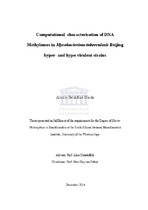| dc.contributor.advisor | Christoffels, Alan | |
| dc.contributor.advisor | Gey van Pittius, Nico | |
| dc.contributor.author | Naidu, Alecia Geraldine | |
| dc.date.accessioned | 2016-01-29T10:57:17Z | |
| dc.date.available | 2016-01-29T10:57:17Z | |
| dc.date.issued | 2014 | |
| dc.identifier.uri | http://hdl.handle.net/11394/4756 | |
| dc.description | Philosophiae Doctor - PhD | en_US |
| dc.description.abstract | Mycobacterium tuberculosis, the causative agent of tuberculosis, is estimated to infect approximately one-third of the world’s population and is responsible for around 2 million deaths per year. The disease is endemic in South Africa which has one of the world’s highest tuberculosis incidence and death rates. The M. tuberculosis Beijing genotype are characterised by having an enhanced virulence capability over other M. tuberculosis strains and are the predominant strain observed in the Western Cape of South Africa. DNA methylation is a largely untapped area of research in M.tuberculosis and has been poorly described in the literature especially given its connection to virulence despite it being well characterised along with its role in virulence in other pathogenic bacteria such as E.coli. The overall aim was to characterise a global DNA methylation profile for two M. tuberculosis Beijing strains, hyper-virulent and hypo-virulent, using single molecule real time sequencing data technology. Moreover, to determine if adenine methylation in promoter regions has a possible functional role. This study identified and characterised the DNA methylation profile at the single nucleotide resolution in these strains using Pacific Biosciences single molecule real time sequencing data. A computational approach was used to discern DNA methylation patterns between the hyper and hypo-virulent strains with a view of understanding virulence in the hyper-virulent strain. Methylated motifs, which belong to known Restriction Modification (RM) systems of the H37Rv referencegenome were also identified. N6-methyladenine (m6A) and N4-methlycytosine (m4C) loci were identified in both strains. m6A were idenitified in both strains occuring within the following sequence motifs CACGCAG (Type II RM system), GATNNNNRTAC/GTAYNNNNATC (Type I RM system), while the CTGGAGGA motif was found to be uniquley methylated in the hyper-virulentstrain.Interestingly, the CACGCAG motif was significantly methylated (p = 9.9 x10 -63) at a higher proportion in intergenic regions (~70%) as opposed to genic regions in both the hyper-virulent and hypo-virulent strains suggesting a role in gene regulation. There appeared to be a higher proportion of m6A occuring in intergenic regions compared to within genes for hyper-virulent (61%) and hypo-virulent (62%) strains. The genic proportion revealed that 35% of total m6A occurred uniquely within genes for the hyper-virulent strain while 27.9% for uniquely methylated genes in hypo-virulent strain. | en_US |
| dc.language.iso | en | en_US |
| dc.publisher | University of the Western Cape | en_US |
| dc.subject | DNA methylation | en_US |
| dc.subject | Methyltransferase | en_US |
| dc.subject | Hyper-virulent strain | en_US |
| dc.subject | Next generation sequencing | en_US |
| dc.subject | Mycobacterium tuberculosis | en_US |
| dc.title | Computational characterisation of DNA methylomes in mycobacterium tuberculosis Beijing hyper- and hypo-virulent strains | en_US |
| dc.rights.holder | University of the Western Cape | en_US |

